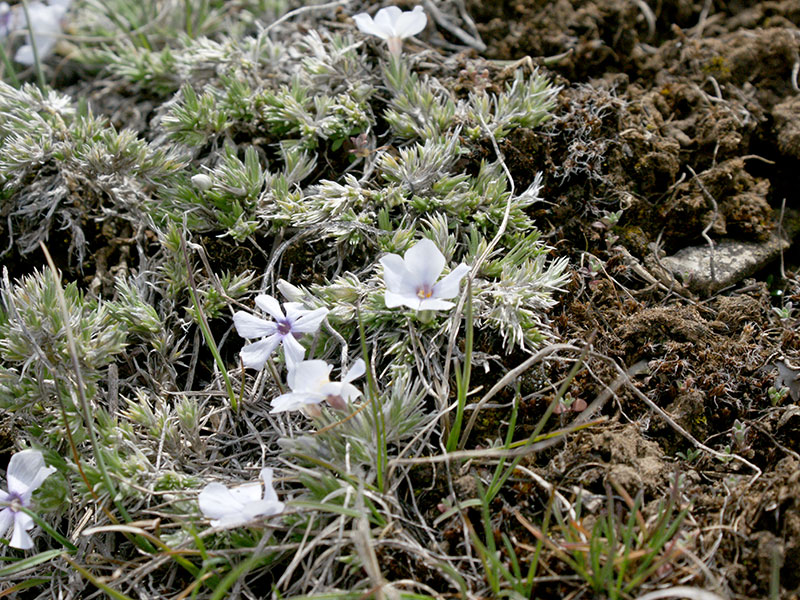Phlox hoodii / spiny phlox
- half-inch, five (or four) petaled flower with yellow center
- low to ground, mat forming, moss-like
- tightly packed, narrow, spiny leaves
- blooms in very early spring, just after snowmelt
- with sagebrush on dry, rocky soils
Also known as: Hood’s phlox, carpet phlox, woolly phlox
See also: Spreading phlox (P. diffusa)
Spiny phlox is a mat forming plant that looks mosslike when vegetative. It grows very close to the ground (just a few inches tall at most). You can’t really see the stems because they have very short internodes. This makes the leaves densely packed, lending to the mosslike appearance. There are numerous subspecies, based largely on the leaves and their hairs. Some of these may sometimes show up as separate species, including P. canescens and P. austromontana. We won’t do that here because it is just too “hand-lens-y” for me.
But if you are of the hand-lens persuasion, you’ll be able to see that the leaves are oppositely arranged and have long, tangled hairs. And if you are a “smeller”, you’ll find them pungent. But take care because they are also prickly sharp (as the common name suggests). The old leaves hang on quite far into the fall, sometimes over winter.
Of course, what really draws your attention to the plant is its beautiful flowers in early spring. Spiny phlox flowers may be white, pink or blue with 5, or sometimes 4, petals. The petals seem to stand apart from the yellow centers and from each other, reflecting the fact that behind them is a short, tubular throat; the sexual parts originate deep within that tube. The flowers grow individually at the end of branches and are only about half an inch across… call them small but not teeny.
Spiny phlox is a perennial, growing from a branched caudex, the woody underground stem. Part of the trick of being this size and stress tolerant as well (which it is) is root based – in rocky/sandy soil the roots can penetrate as deep as 36 inches. Although mostly growing back from the caudex in the spring, there is some evidence for seed banking; seed longevity is not known.
Spiny phlox is common in sagebrush country, especially in dry open places amongst the sagebrush. Although it is perennial, some bits of its life cycle are distinctly ephemeral. It is, for example, among the first plants to bloom in spring – and certainly the first phlox – after the snow has melted and before the surrounding vegetation gets high enough to shade it. A number of studies have indicated that spiny phlox is more or less limited to areas with earlier snowmelt, being much less common for (say) May or June melting places. In the Valley, it shows up mid-April, slightly upslope in exposed, melted areas.
Although it will grow in disturbed areas, it does best when it is in undisturbed habitats. Still, it seems to increase in grazed but non-pasture habitats (perhaps because it is small enough to escape being eaten), and it typically shows up after fires (from seed banks).
Spreading phlox (P. diffusa) is a somewhat similar species being low, compact and spreading, but its leaves are wider and softer – less spiny – when you lean on them. It also blooms later and is more widespread in the Valley proper.
| Color | |
|---|---|
| Family | |
| Blossom size | |
| Inflorescence size | |
| Inflorescence type | |
| When? | |
| Where? |



